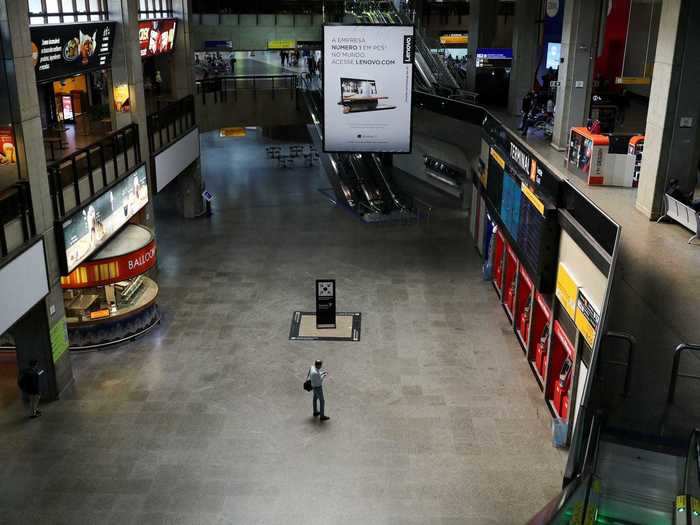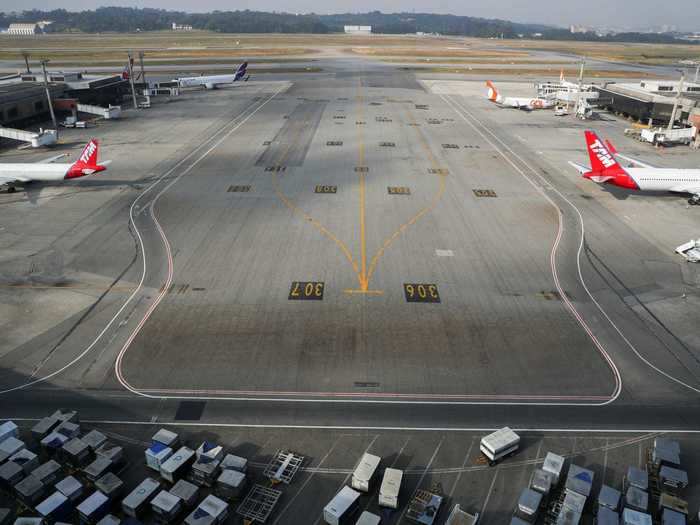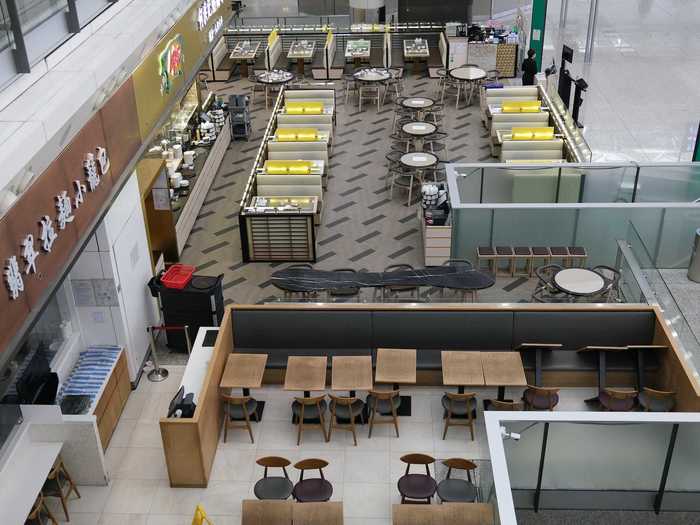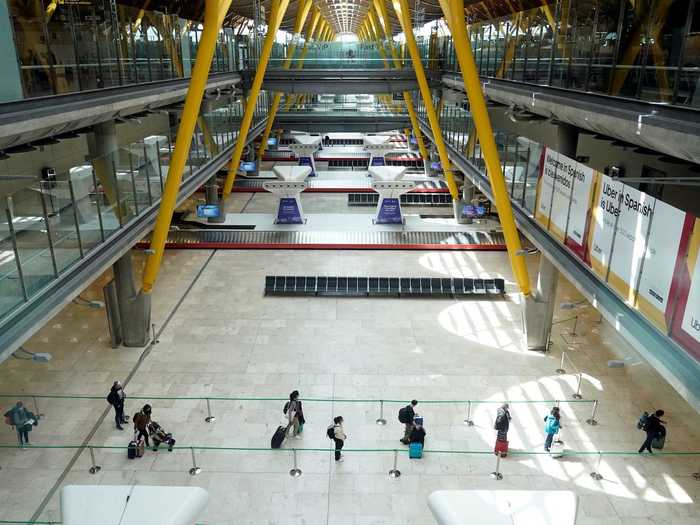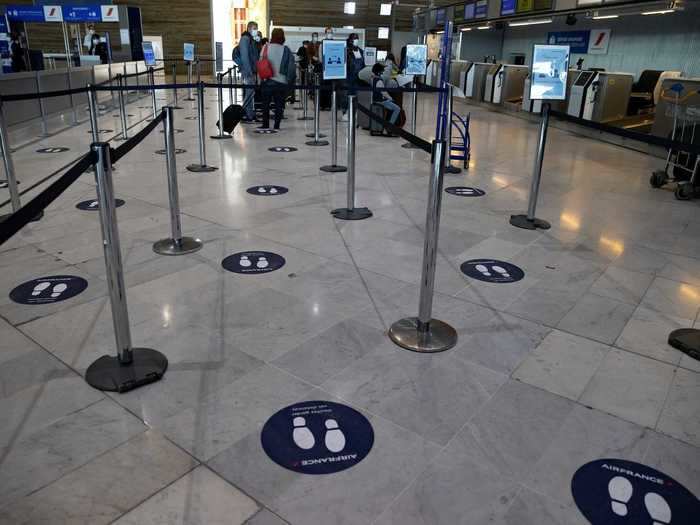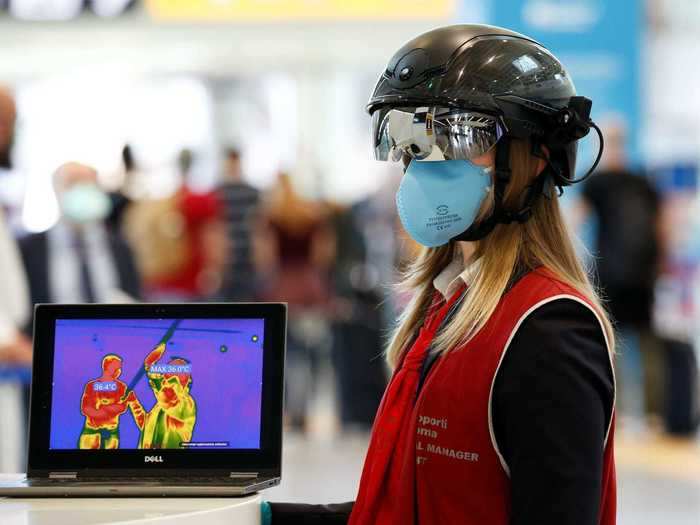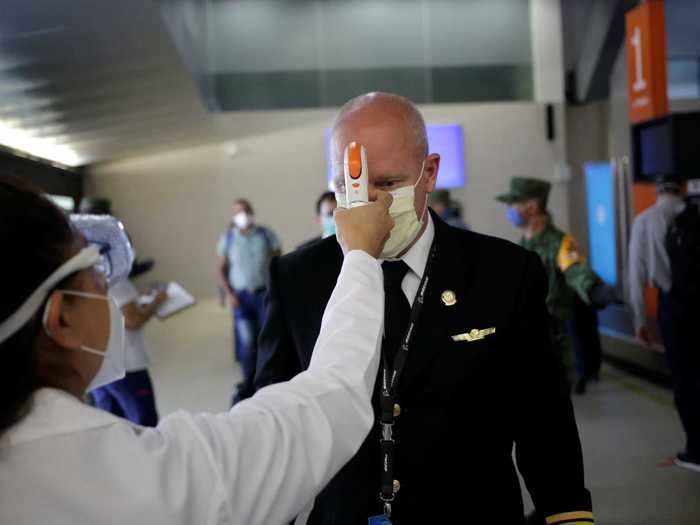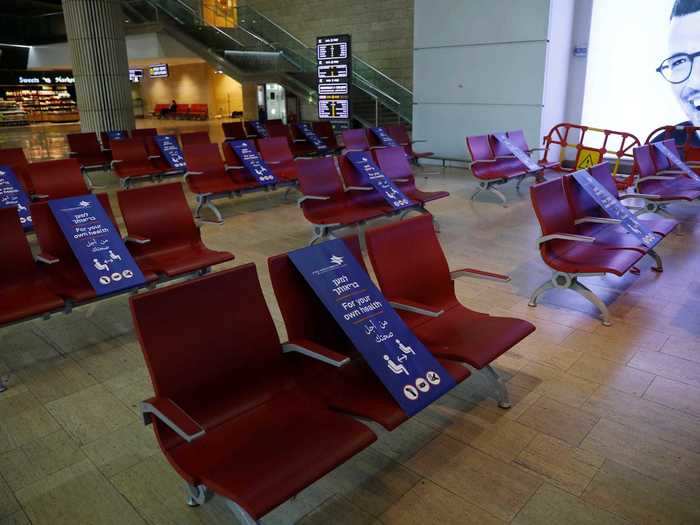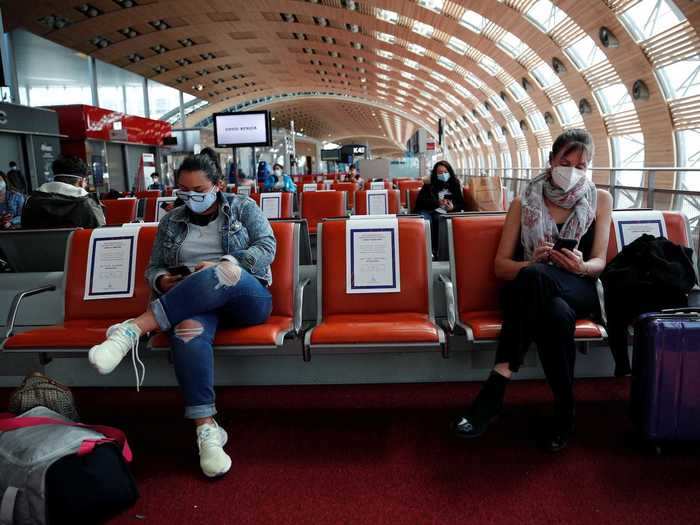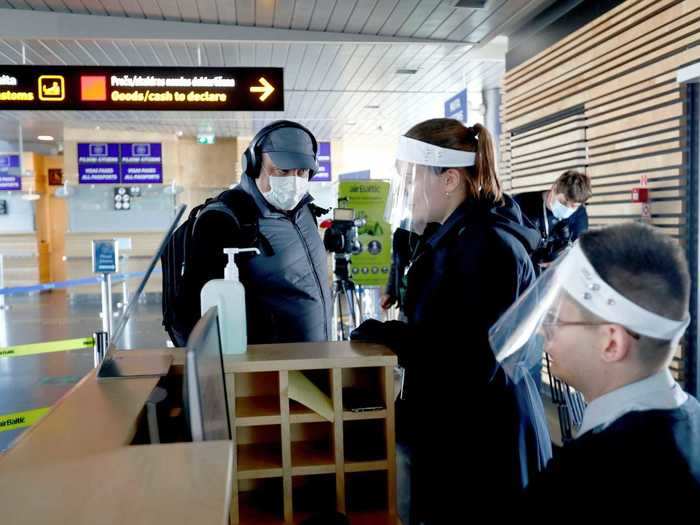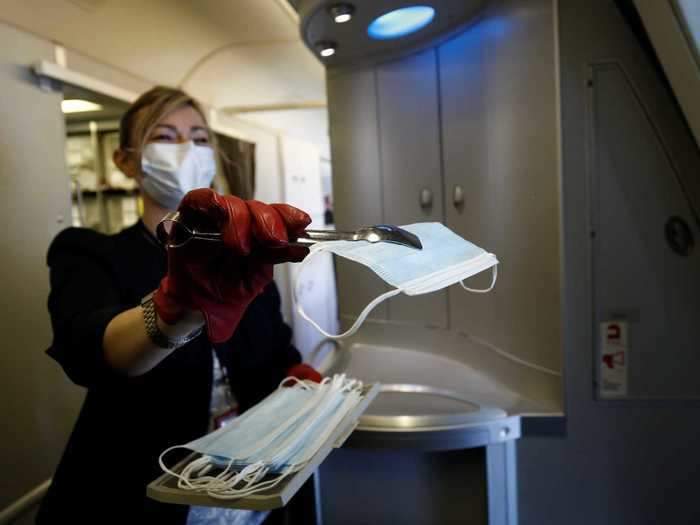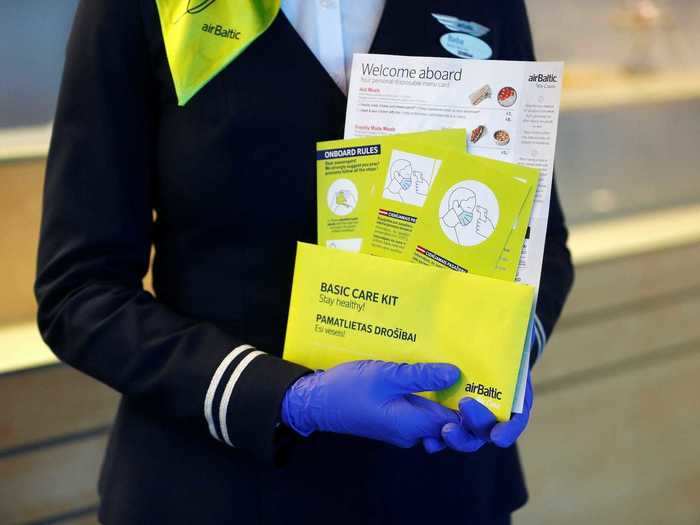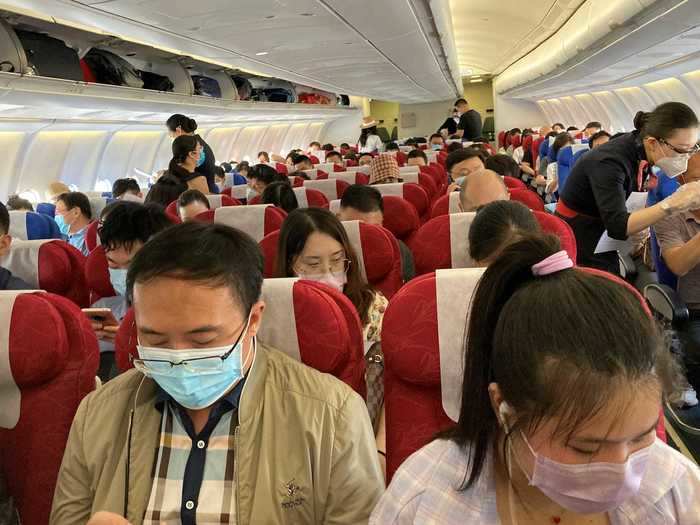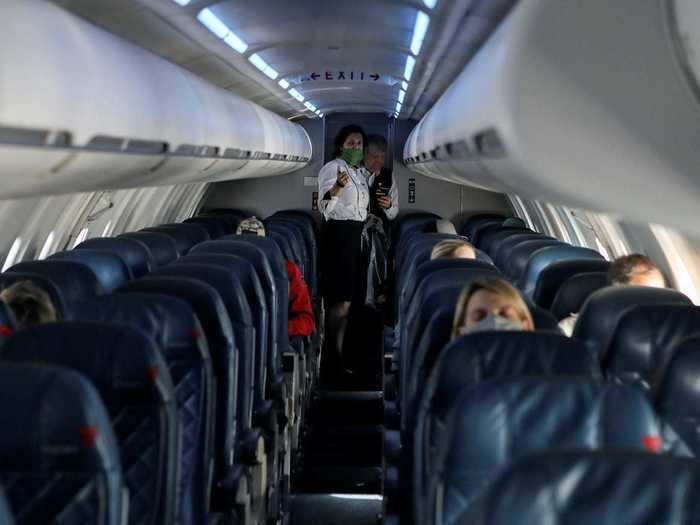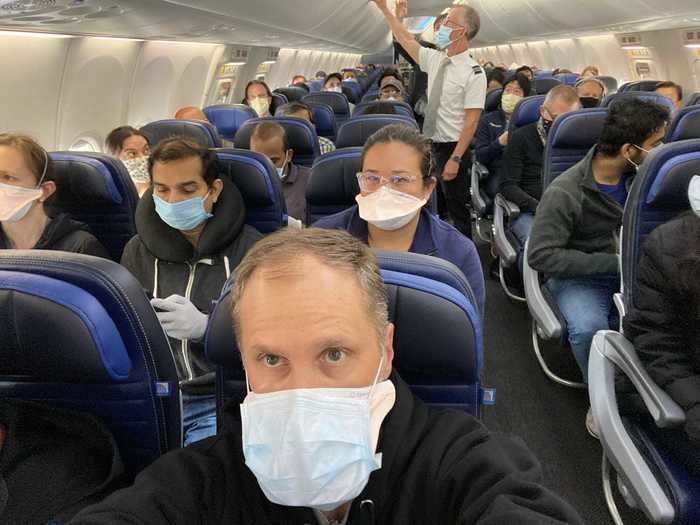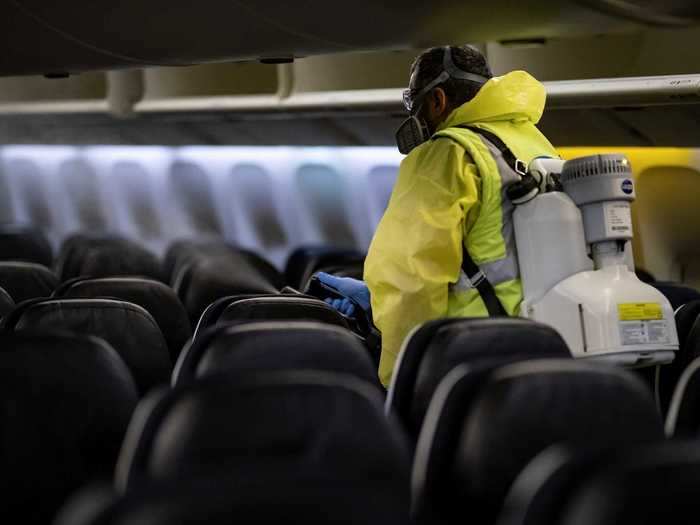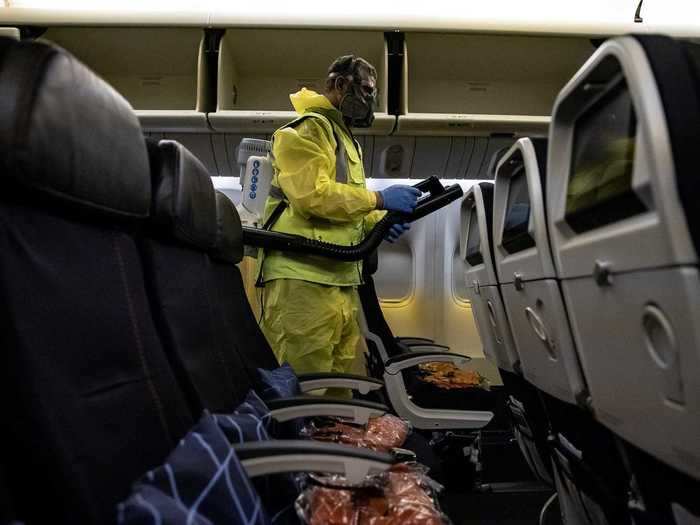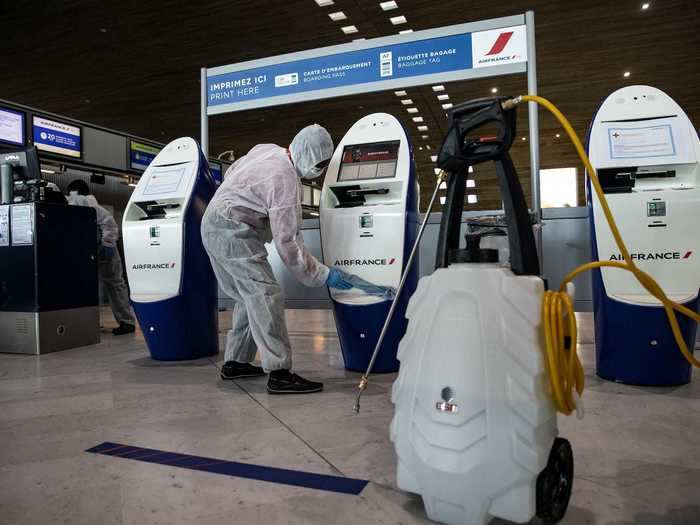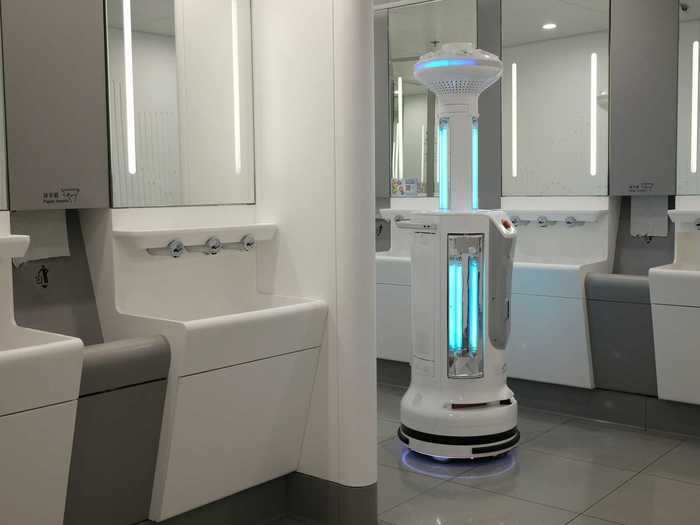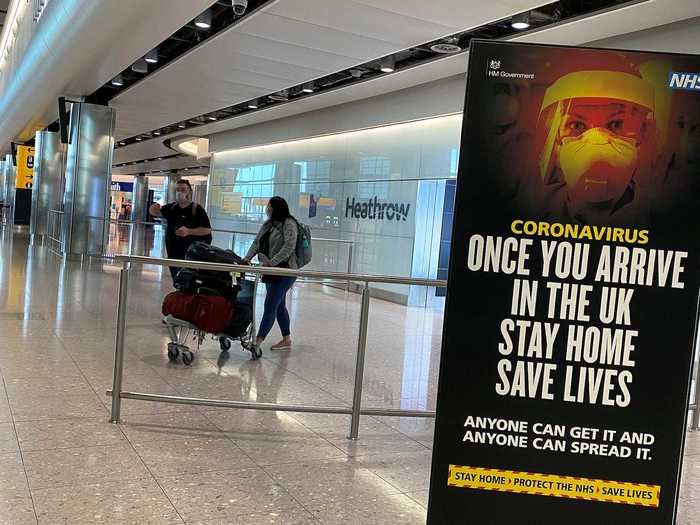Air France flight crew members wearing protective face masks distribute face masks to passengers at Paris Charles de Gaulle airport in Roissy-en-France during the outbreak of the coronavirus disease (COVID-19) in France on May 6, 2020Benoit Tessier/REUTERS
- The coronavirus pandemic has rapidly transformed the way we fly, if we're flying at all.
- Though air travel has seen a significant decrease, airlines have scrambled to implement new protective measures to make passengers and crew feel safe during the pandemic.
- Around the world, airlines are administering temperature checks, requiring passengers wear face masks, and implementing new ways to disinfect planes and terminals.
Flying during the coronavirus pandemic is an entirely new experience.
In a matter of months, the pandemic has significantly transformed the way airlines and passengers operate. Though air travel has seen a drastic decline, people around the world are still booking necessary flights, and airlines have had to implement new safety policies for customers and crew members.
In most cases, wearing a face mask on flights has become customary.
Thermal body scanners, electronic temperature checks, sanitation stations, and sweeping disinfection policies are just a few of the many new practices that have become commonplace in airports around the world.
These photos show what it looks like to fly right now.
Read the original article on
Business Insider
The coronavirus pandemic has left airports looking eerily empty. In the US alone, air travel demand has fallen as much as 95%.
A man looks at his phone as he stands alone in the empty hall of Guarulhos International Airport amid the outbreak of the coronavirus disease (COVID-19), in Guarulhos, near Sao Paulo, Brazil, May 19, 2020.
Amanda Perobelli/REUTERS
In Brazil, an empty runway is seen at the Guarulhos International Airport on May 19.
A few airplanes and luggage carts are seen at Guarulhos International Airport as air traffic is affected by the outbreak of the coronavirus disease (COVID-19), in Guarulhos, near Sao Paulo, Brazil, May 19, 2020.
REUTERS/Amanda Perobelli
The International Air Transport Association has previously warned that European airlines could see demand drop 55% this year. Here, empty luggage carts are seen in France, where travel restrictions have been strict.
Empty luggage carts are pictured at Paris Charles de Gaulle airport in Roissy-en-France during the outbreak of the coronavirus disease (COVID-19) in France May 19, 2020.
Charles Platiau/REUTERS
Airport restaurants have been left abandoned, as well. In this photo, dining areas at the Hong Kong International Airport are completely shuttered.
A general view of restaurants at the Hong Kong International Airport, following the coronavirus disease (COVID-19) outbreak, in Hong Kong, China May 7, 2020.
Tyrone Siu/REUTERS
But people are still booking flights for necessary travel. In this photo at an airport in Spain, passengers are seen lining up six feet apart to check in at an otherwise empty terminal.
Passengers queue upon arriving at the Adolfo Suarez Barajas Airport, after the Spanish government announced that from May 15th all people entering the country will have to go under quarantine for two weeks, amid the coronavirus disease (COVID-19) outbreak, in Madrid, Spain, May 15, 2020.
Juan Medina/REUTERS
Some airports have begun implementing social distancing by using labels across the floor that tell passengers where to stand while they check in for a flight, like these at Charles de Gaulle in Paris.
Stickers mark out social distancing spacing on the floor at the check-in queue for Air France, in Terminal 2 of Charles de Gaulle International Airport, amid France's gradual easing of its lockdown measures and restrictions during the outbreak of the coronavirus disease (COVID-19), in Roissy near Paris, France May 14, 2020.
Ian Langsdon/Pool via REUTERS
At security, some airports have implemented thermal scanners that check a passenger's body heat, as a way to detect a fever. But about a quarter of coronavirus patients don't develop a fever, and many don't have symptoms at all.
An airport official wears a 'Smart Helmet', a portable thermoscanner that can measure the temperature of passengers at a distance, at the Fiumicino airport, after Italy begun a gradual end to a nationwide lockdown due to the coronavirus disease (COVID-19), in Rome, Italy May 6, 2020.
Remo Casilli/REUTERS
Thermal scanners were previously used in some airports during the SARS outbreak in 2003, and the Ebola scare in 2014. Rather than having airport personnel physically scan people before a flight, thermal scanners can monitor body heat on a television screen from a distance.
A thermal scanner is seen as flights resume during the coronavirus disease (COVID-19) outbreak in Riga international airport, Latvia May 18, 2020.
Ints Kalnins/REUTERS
Many airports around the world are also administering temperature checks via electronic thermometers for both passengers and crew members.
A pilot gets his temperature checked at a sanitary checkpoint, during a media tour to show sanitary measures taken against the coronavirus disease (COVID-19), at Mariano Escobedo International Airport in Apodaca, Mexico May 18, 2020.
Daniel Becerril/REUTERS
While passengers wait to board the plane, many airports have created social distancing guidelines in terminals so people can be spaced apart from one another.
Seats covered in social distancing markers are seen at the arrivals terminal as Israel's airport authority announced a pilot programme revealing what passengers leaving Israel should except as air travel gradually returns to normal after weeks of bare minimum flights due to the coronavirus disease (COVID-19) outbreak, at Ben Gurion International Airport, in Lod, near Tel Aviv, Israel May 14, 2020.
Ronen Zvulun/REUTERS
Here, passengers at Charles de Gaulle are seen spaced out every other seat.
Passengers, wearing protective face masks, wait to board an Air France flight to Mexico City in Terminal 2E at Paris Charles de Gaulle airport in Roissy-en-France during the outbreak of the coronavirus disease (COVID-19) in France, May 6, 2020.
Benoit Tessier/REUTERS
In many cases, airline workers have begun wearing personal protective equipment (PPE), such as face shields, and hand sanitizing stations have been set up throughout airports.
A man boards on a plane as flights resume during the coronavirus disease (COVID-19) outbreak in Riga international airport, Latvia May 18, 2020.
Ints Kalnins/REUTERS
Some airlines, including Air France and American Airlines, are even giving out face masks to customers for free.
Air France flight crew members wearing protective face masks distribute face masks to passengers at Paris Charles de Gaulle airport in Roissy-en-France during the outbreak of the coronavirus disease (COVID-19) in France, May 6, 2020
Benoit Tessier/REUTERS
Others are giving out informational booklets and coronavirus kits on how to stay safe during the pandemic.
A flight attendant displays information booklets as flights resume during the coronavirus disease (COVID-19) outbreak in Riga international airport, Latvia May 18, 2020.
Ints Kalnins/REUTERS
Wearing a face mask on flights has become the new norm. Most major US and international airlines are recommending the use of a face mask, and the International Air Transport Association has said it supports the mandatory use of masks.
Passengers wearing face masks following the coronavirus disease (COVID-19) outbreak are seen on a China Eastern Airlines flight at Shenzhen Baoan International Airport in Shenzhen, Guangdong province, China May 19, 2020.
Martin Pollard/REUTERS
In some cases, flights have been left under-booked. In April, over half of flights in the US were canceled, and fewer than one in 10 seats were filled on some planes.
Flight attendants talk in a nearly empty cabin on a Delta Airlines flight operated by SkyWest Airlines as travel has cutback, amid concerns of the coronavirus disease (COVID-19), during a flight departing from Salt Lake City, Utah, U.S. April 11, 2020.
REUTERS/Jim Urquhart/File Photo
But as states and countries begin easing up on stay-at-home orders, flights are starting to become more crowded.
A United Airlines flight from Newark to San Francisco is crowded with passengers in this picture obtained from social media May 9, 2020.
Ethan Weiss/via REUTERS
To protect passengers and crew members, disinfection has become a key step in the battle against the coronavirus.
A member of Charles de Gaulle airport personnel nebulizes the interior of an Air France aircraft as part of a disinfection process for airplanes, at Terminal 2 of Charles de Gaulle International Airport, amid France's gradual easing of its lockdown measures and restrictions during the outbreak of the coronavirus disease (COVID-19), in Roissy near Paris, France May 14, 2020.
Ian Langsdon/Pool via REUTERS
Airlines have been sending personnel in full PPE to clean off seats, and disinfect frequently touched surfaces.
A member of Charles de Gaulle airport personnel nebulizes the interior of an Air France aircraft as part of a disinfection process for airplanes, at Terminal 2 of Charles de Gaulle International Airport, amid France's gradual easing of its lockdown measures and restrictions during the outbreak of the coronavirus disease (COVID-19), in Roissy near Paris, France May 14, 2020.
Ian Langsdon/Pool via REUTERS
The same goes for airport terminals and check-in areas.
Personnel members clean machines, in Terminal 2 of Charles de Gaulle International Airport, amid France's gradual easing of its lockdown measures and restrictions during the outbreak of the coronavirus disease (COVID-19), in Roissy near Paris, France May 14, 2020.
Ian Langsdon/Pool via REUTERS
At the Hong Kong International airport, sanitation robots are being used to disinfect and kill the virus on frequently touched surfaces with ultraviolet light.
An Intelligent Sterilization Robot (ISR), produced by TMiRob of China, uses UV light to sanitize, at a toilet, following the coronavirus disease (COVID-19) outbreak, at the Hong Kong International Airport, in Hong Kong, China May 7, 2020. Picture taken May 7, 2020.
Tyrone Siu/REUTERS
Once passengers arrive, most countries recommend they self-quarantine for 14 days to keep from spreading the virus if they have it.
A public health campaign advert is seen as passengers arrive from international flights at Heathrow Airport, as the spread of the coronavirus disease (COVID-19) continues, in London, Britain, on May 10, 2020.
REUTERS/Toby Melville

